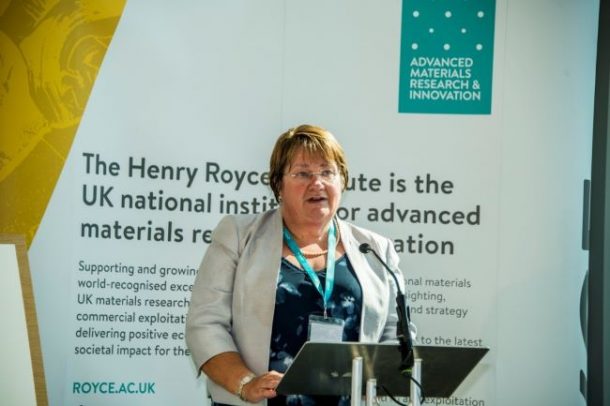
NAA Project News: NAA’s FAST STEP 3 project part of formal opening of the Henry Royce Institute Hub
The NAA’s FAST STEP 3 project was part of the formal opening of the Henry Royce Institute Hub building at the University of Manchester on 7th September.
Carol Holden gave a presentation on the role of Royce in the development of the FAST STEP 3 project and the importance of light-weighting for the Automotive Industry.
The formal opening of the £105m Henry Royce Institute Hub Building at The University of Manchester was by Professor Dame Ottoline Leyser, CEO, UK Research and Innovation (UKRI).
Professor Dame Nancy Rothwell, President and Vice-Chancellor at The University of Manchester and Dame Julia King, the Baroness Brown of Cambridge and Chair of the Henry Royce Institute, welcomed guests to Royce’s flagship building at the university and set out the capabilities of the new UK centre for materials research and meeting place for the advanced materials community.
Following a tour of the building’s laboratories and meeting researchers, Dame Ottoline unveiled a plaque marking the official opening of the Royce Hub Building, which will be the hub to 400 researchers, PhD Students and professional services staff driving research and innovation in advanced materials.
The event also saw an important keynote video message from The Rt Hon Kwasi Kwarteng MP, Secretary of State for Business Energy and Industrial Strategy, who highlighted the importance of Government investment in innovation and technology translation. The Business Secretary noted that Advanced Materials & Manufacturing is a key technology family of “UK strength and opportunity”, as highlighted in the Government’s recently announced UK Innovation Strategy: Leading the future by creating it
The building hosts £45 million of new state-of-the-art equipment alongside existing facilities in Manchester for biomedical materials, metals processing, digital fabrication, and sustainable materials research, including the new Sustainable Materials Innovation Hub part-funded by the European Regional Development Fund (ERDF). Alongside this is a variety of collaboration spaces for industry engagement, helping to accelerate the development and commercialisation of advanced materials.
During the event, Carol Holden OBE from the Northern Automotive Alliance presented on the Royce role in industrial innovation and Mia Maric, winner of IOM3 Young Person’s Lecture Competition, talked about her Manchester PhD experience and the benefits of using Royce’s equipment and expertise in her research.
The Royce Hub Building in Manchester sits at the centre of the Institute’s national Partnership with eight other leading institutions – the universities of Cambridge, Imperial College London, Liverpool, Leeds, Oxford, Sheffield, the National Nuclear Laboratory, and UKAEA.
Professor Dame Ottoline Leyser, UK Research and Innovation Chief Executive said:
“The Henry Royce Institute will play a key role in the UK’s research and innovation ecosystem, bringing together industry and academia to connect innovation and discovery in advanced materials, and develop the material science skills needed for the innovation economy.
“This Institute will deliver impact across the UK – from the new materials needed to realise our Net Zero ambitions to novel biomaterials for personalised medicine.”
Business Secretary Kwasi Kwarteng said:
“The UK has a globally competitive advantage in advanced materials and manufacturing and our new Innovation Strategy sets out our ambition to capitalise on our unique capabilities to fire up our economy.
“Backed by government, this new multi-million-pound centre at the Henry Royce Institute will provide state-of-the-art facilities for the UK’s most innovative researchers to drive forward advanced materials research and commercialise new technologies and products that could help transform whole industries – from life sciences to renewable energy.”
Professor Dame Nancy Rothwell, President and Vice-Chancellor University of Manchester said:
“We were delighted to welcome Dame Ottoline to the new Royce Hub building, to officially mark its much anticipated opening and to cement the building’s role as a centre of scientific excellence and a key asset for Manchester and the UK’s industrial prosperity and success.”
Baroness Brown of Cambridge (Julia King), Henry Royce Institute Chair, said:
“Royce was delighted to welcome the Government’s recently announced Innovation Strategy, which sets out Advanced Materials and Manufacturing as a key technology, and we stand ready to play a role in its delivery. This new flagship building will not only provide a centre for advanced materials research, critically it will help industry to translate such research into ground-breaking applications for commercial use.”
Professor David Knowles, Henry Royce Institute CEO said:
“The Royce Hub offers a unique combination of materials science expertise, state-of-the-art laboratories and fantastic collaboration space. We can now start working with the whole UK community, developing the next generation of materials scientists, driving innovation with industry and engaging with the public – supporting the UK in sustainable growth and development.”
Professor Philip Withers, Henry Royce Institute Chief Scientist said:
“Research and innovation in advanced materials are critical to tackling today’s global challenges; from decarbonising the energy sector, to delivering major advances in healthcare. This fantastic new Royce Hub Building will be a flagship for the UK, bringing together academia and industry. The research conducted here and across the national Partnership will play an important role in the development of game-changing products and components across a range of UK industries including aerospace, life sciences, chemicals, automotive, next generation nuclear and renewable energy.”
The Royce Hub Building and new equipment totalling £150 million forms part of the wider £235m investment by the Engineering & Physical Sciences Research Council part of UK Research and Innovation across Royce’s national partnership. Investment has also be made by The Wolfson Foundation to support the biomedical materials facility within the building, alongside ERDF funding for the SMI Hub, representing a wider investment of C. £330 million.
Royce’s presence in Manchester extends well beyond the new building; it also has substantial space and equipment in the Alan Turing Building, along with facilities in the National Graphene Institute, Manchester Institute of Biotechnology and at the Dalton Nuclear Institute. Soon it will also extend its reach into the new Manchester Engineering Campus Development – the MECD – which is the single largest home for engineering in any UK university.
About the Henry Royce Institute
The Henry Royce Institute is the UK national institute for advanced materials research. Operating with its Hub at The University of Manchester, the Institute is a Partnership of nine leading institutions – the universities of Cambridge, Imperial College London, Liverpool, Leeds, Oxford, Sheffield, the National Nuclear Laboratory, and UKAEA. In 2020, Cranfield University joined as an Associate Partner. Royce aims to support and grow world-recognised excellence in UK materials research, accelerating commercial exploitation and delivering positive economic and societal impact for the UK. The Institute is funded by the Engineering and Physical Sciences Research Council, part of UK Research and Innovation.
About the Royce Hub Building
The design of the nine story Royce Hub Building was driven by a vision to engage scientists, industry and the public by showcasing the Institute’s work and providing a flexible environment for world-class research. Featuring a geometric façade, the 16,000m2 Hub Building features a variety of spaces including high specification laboratories, heavy duty testing areas, offices and contemporary industry collaboration spaces.
The 10-metre-high ground floor entrance is overlooked by a mezzanine and offers views into the material testing spaces. Terraced floors provide visitors with glimpses into workspaces as they climb the distinctive staircase through a stepped, three-storey atrium. These atria house local collaboration hubs with lounge seating and views out across The University of Manchester’s campus and city beyond.
The Royce Hub Building, under the Project and Cost Management of Arcadis (who contracted as Project Managers and Full Design Team), was designed by NBBJ, an international architectural practice, alongside civil and structural engineers Ramboll and building services engineers Arup. Ramboll also provided client-side Mechanical, Electrical and Public Health support for the final stages of the main build, as well as the complex fit-out of the laboratories. Equipment hook up and some laboratory and office fit-out was undertaken by Balfour Beatty Kilpatrick. The building was delivered by Laing O’Rourke, the appointed University of Manchester contractor.





